Choice of furniture for the kitchen from the standpoint of practicality: which cases and facades prefer, taking into account the materials used for their manufacture of materials
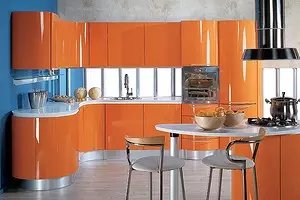
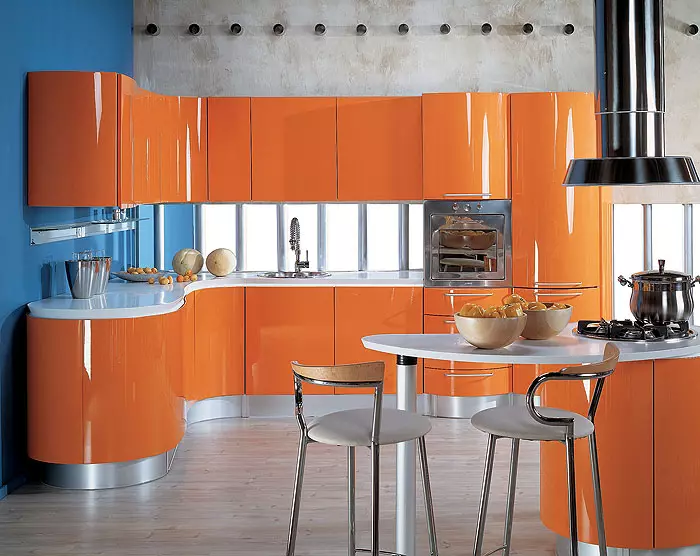
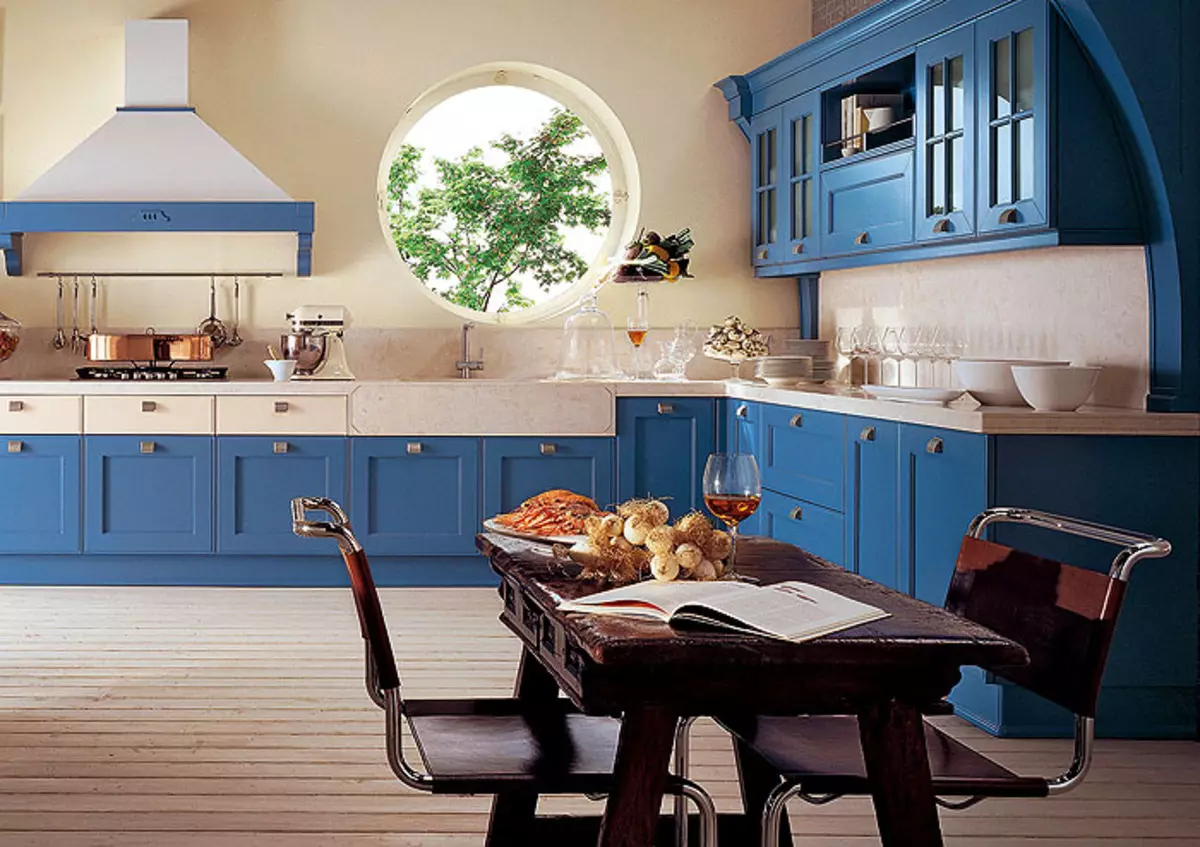
Palladio- Furniture made under ancient with the use of modern technologies. It is inherent in a strict style, aged color gamut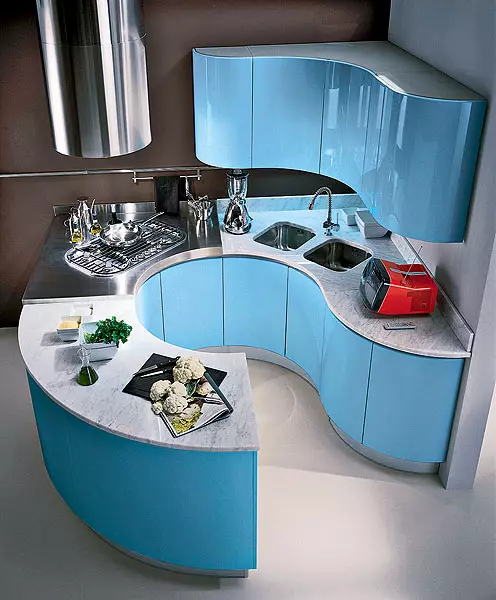
Kitchen Timo Plus (Biefbi). After a multi-layer coating of the glossy lacquer, the facades acquire a perfectly smooth surface with deep mirror glitter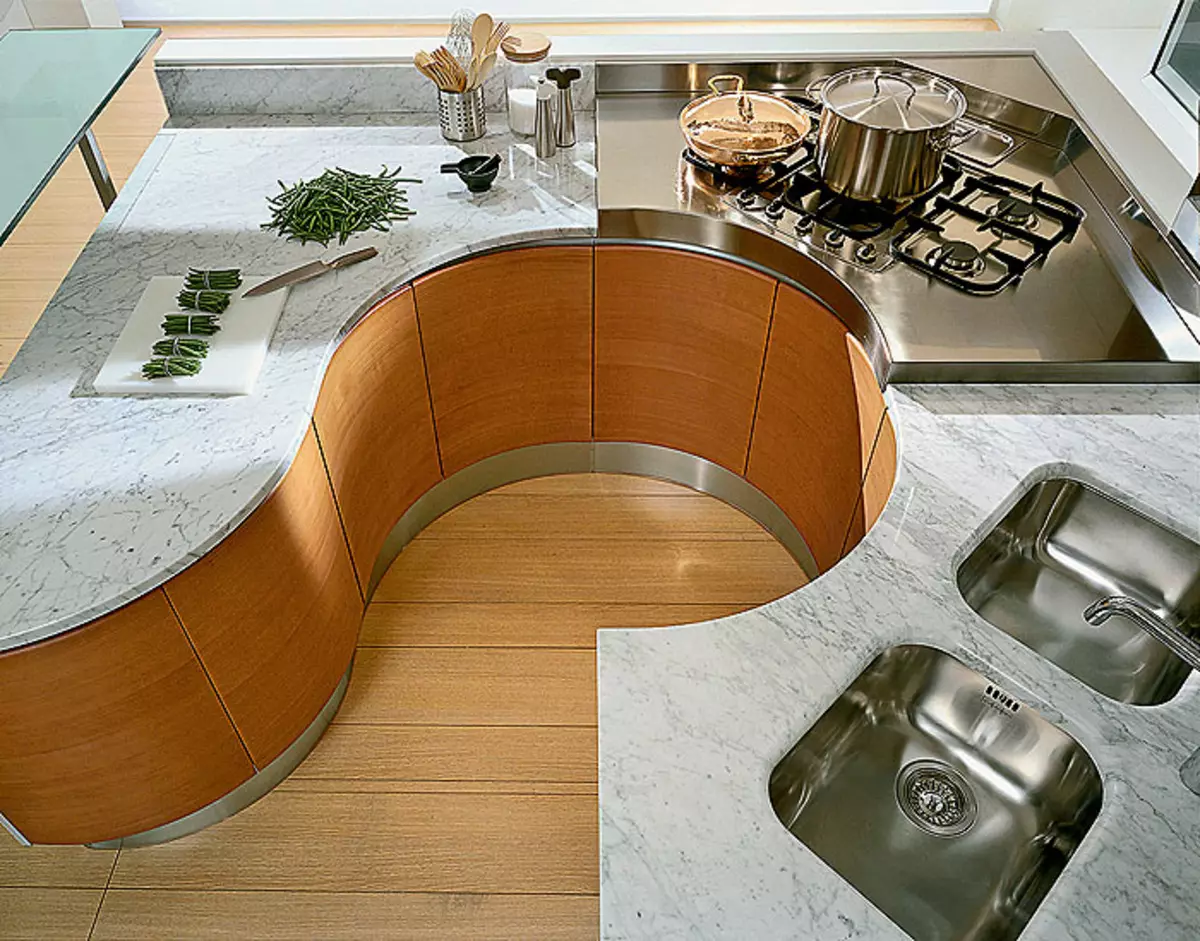
Thanks to the curved forms of Artica kitchen (Pedini), an ergonomic space can be organized, not overloaded with parts. Invisible built-in handles do not disturb the pattern of facades, lined with veneer cherries and organically combined with a marble tabletop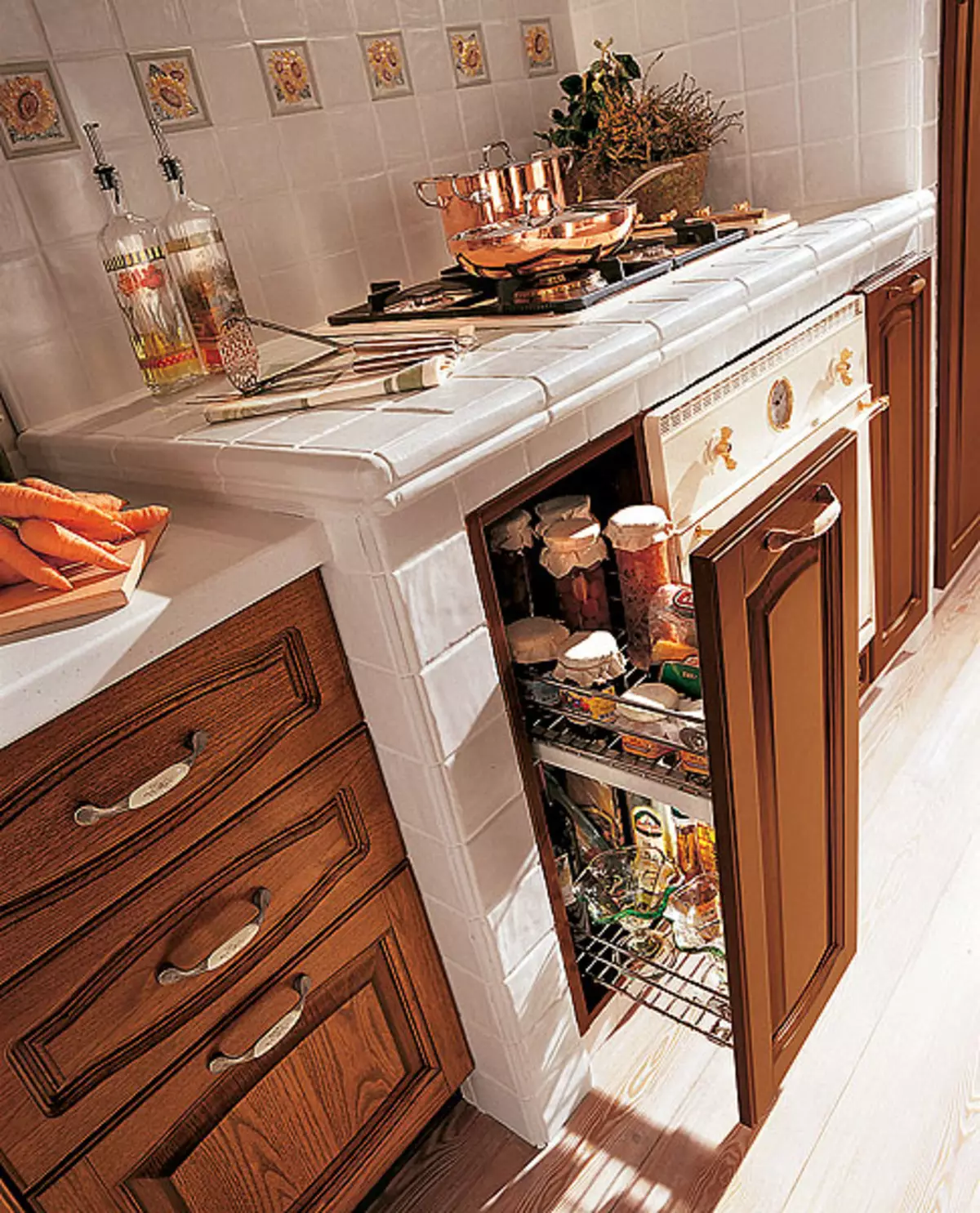
Made from the acacia massif model Michela is the embodiment of romantic ideas about the home focus, warm and comfort. Style logic correspond to curly fillets, brass knobs decorated with ceramics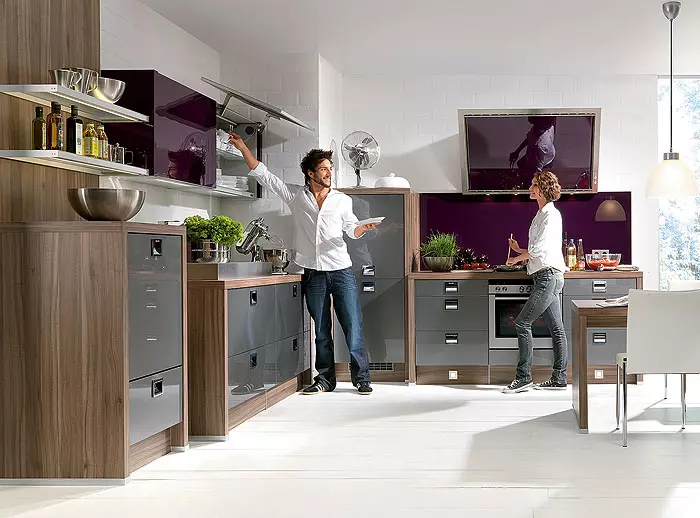
More than the latest Nolte Kuchen- Chicago models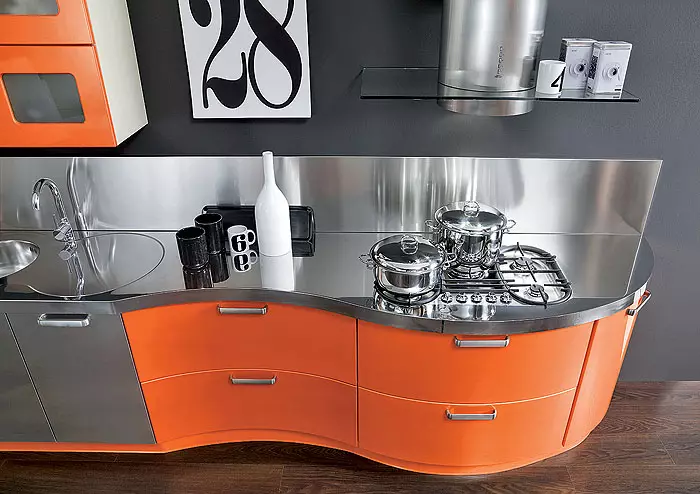
Lucky model. Bent facades from MDF thick 21mm covered with glossy varnish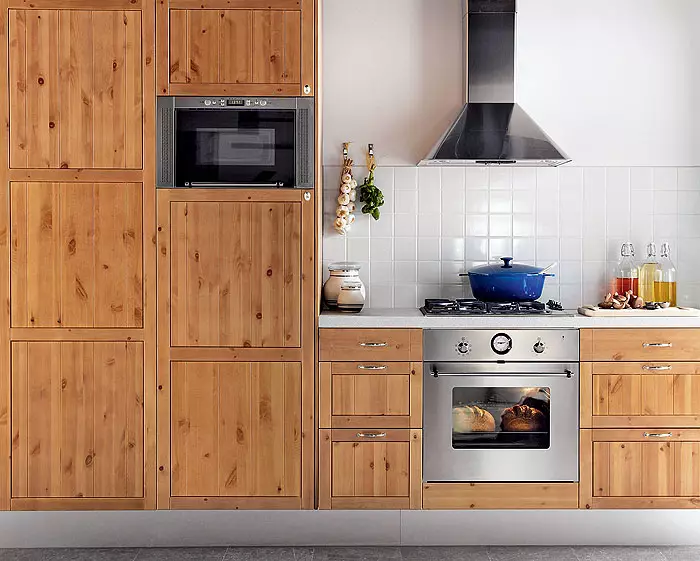
Kitchen made of pine massifs with deaf frame facades (IKEA) - an economical option of a rational modern organization of space. Enough space is all necessary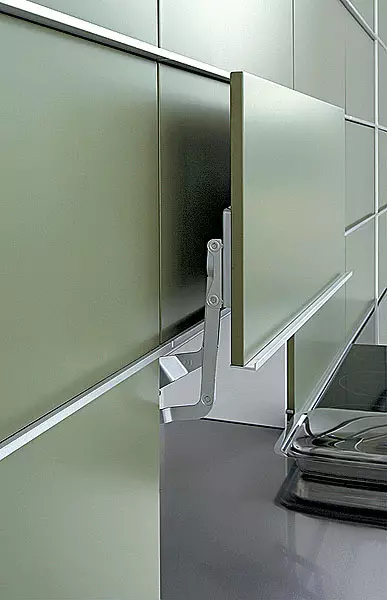
The set in modern style was awarded Interior Innovation Award 2008 ("Cologne-2008"). Wall above the working surface is closed with deaf smooth rectangular cabinets without pens, doors open up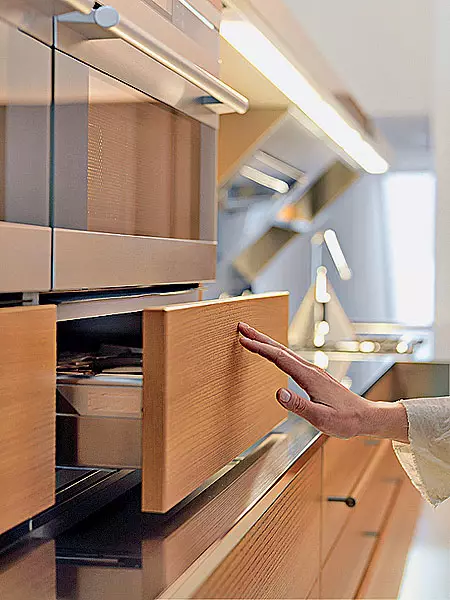
Distinctive features of Kube-horizontal kitchens and vertical lines. She perfectly fits into the interior in the style of minimalism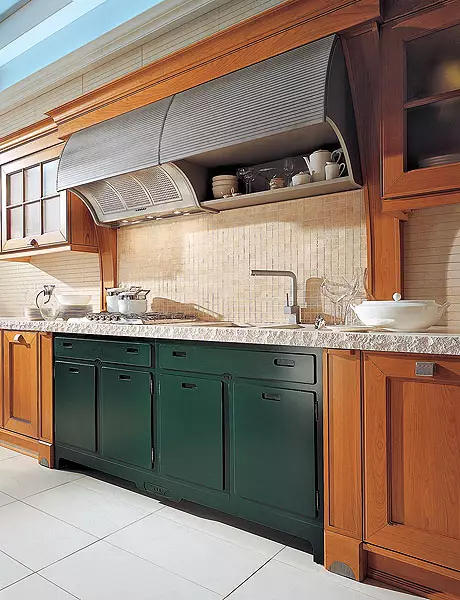
Classic style is relevant and in the modern interior. Furniture made in the best traditions of this direction are brought elements of artistic improvisation, and the colors and details are carefully chosen.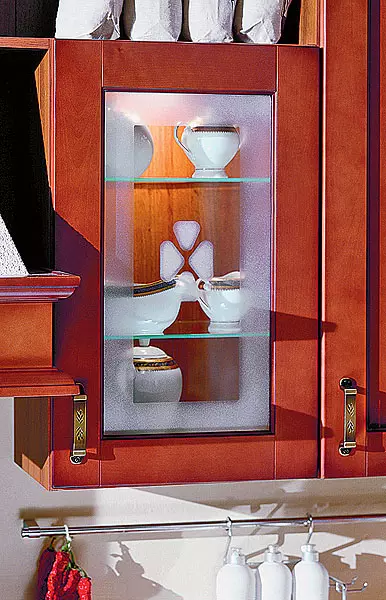
Model "Hope" - a compromise between classics and modernity. Elegant patterns on the doors are combined with the straight frames of the facade of the birch array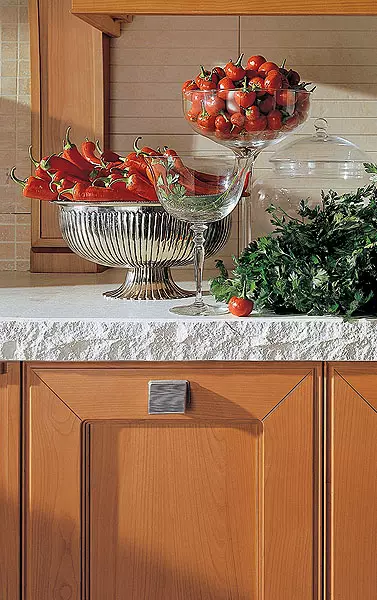
Classic kitchens have worked out parts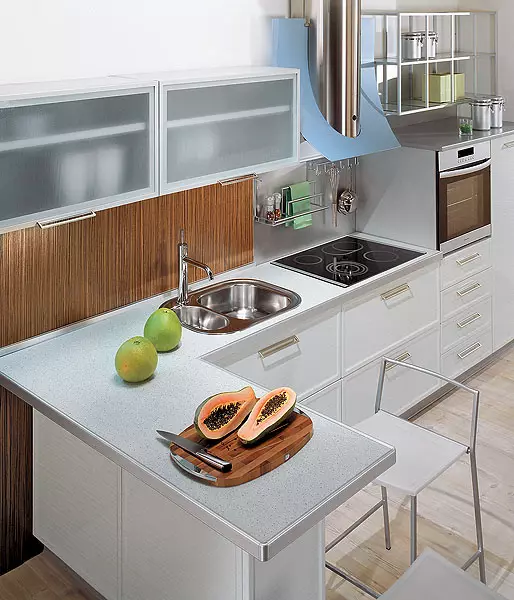
Kitchen VONGOLA. The latest design designers made it possible to create the illusion of an additional relief of the sash, at the same time the whole composition is air, light. The basis of it is MDF (23mmm), the coating is a high-strength PVC film of three colors with a pearl tide. The frame is made of EGGER chipboard, lined with PVC edge Rehau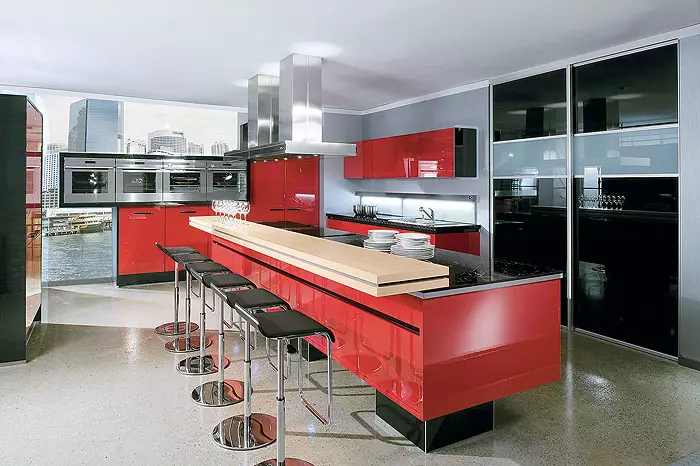
Kitchen compounded in all rules of minimalism. Materials: MDF and high varnish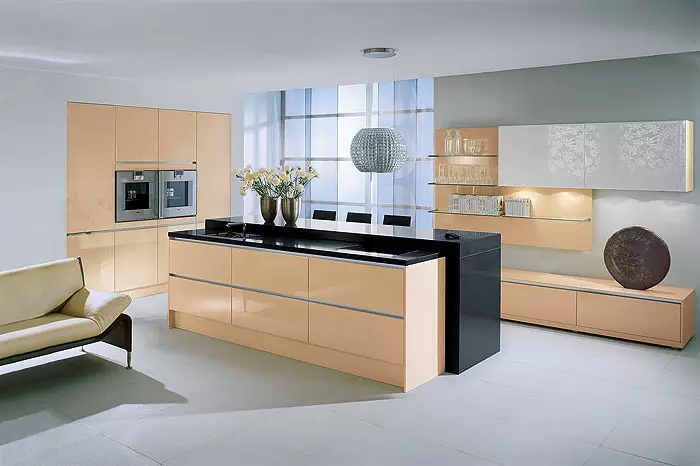
Contrasts in Emotion Kitchen Design will not leave you indifferent. A tabletop thick 12mm is made of granite, and on the glass, from which the facades are made, flowers bloom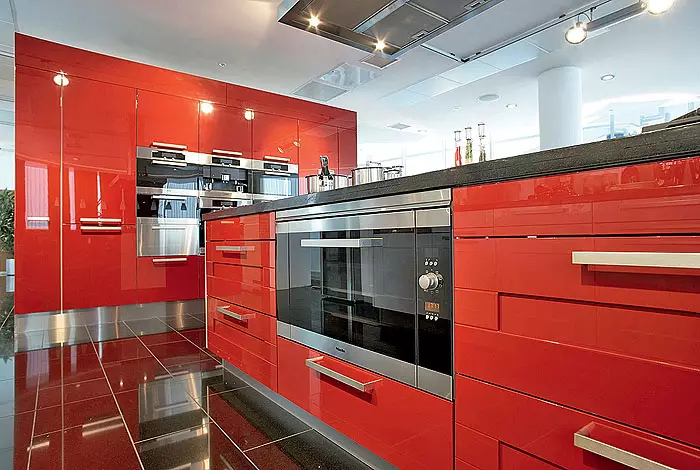
Miele uses yacht varnishes for their kitchens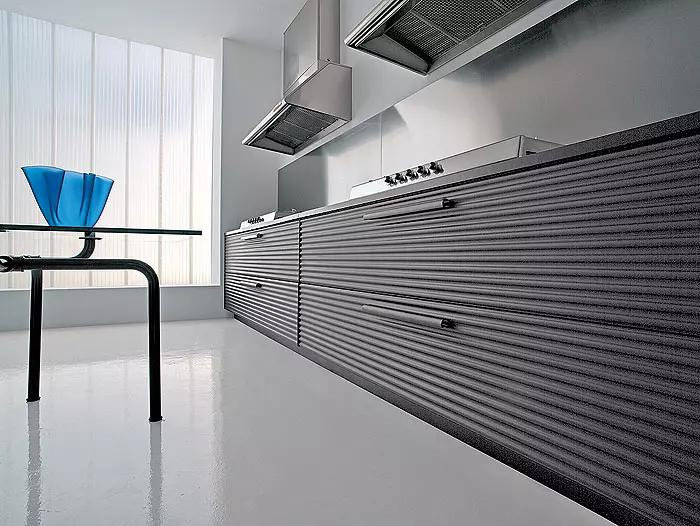
Cinqueterre cuisine facades with a wave-like pattern made of anodized aluminum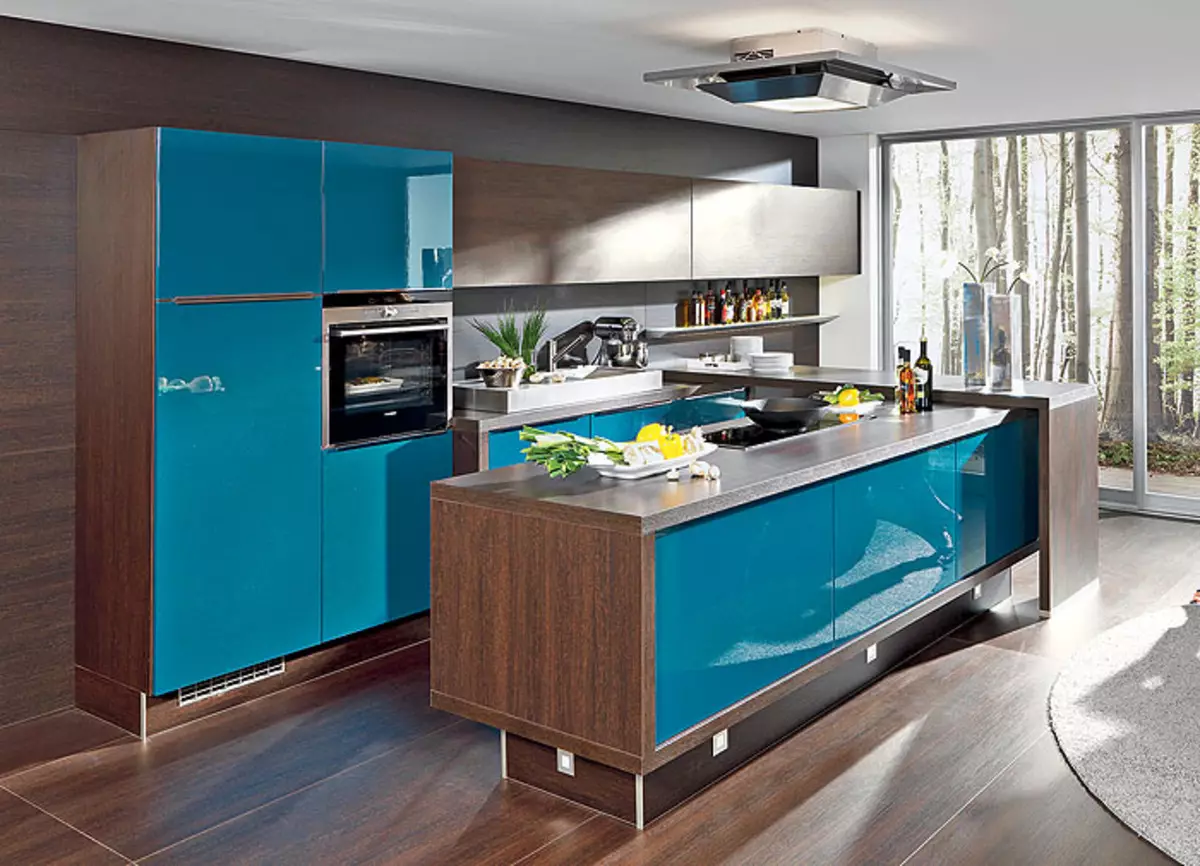
Chicago line characterize bright high-gloss lacquer facades. Finnish 2009 This is a sea wave color (Ocean Metallic High Glass), which is very expressive in combination with finishing "Amazonian Tick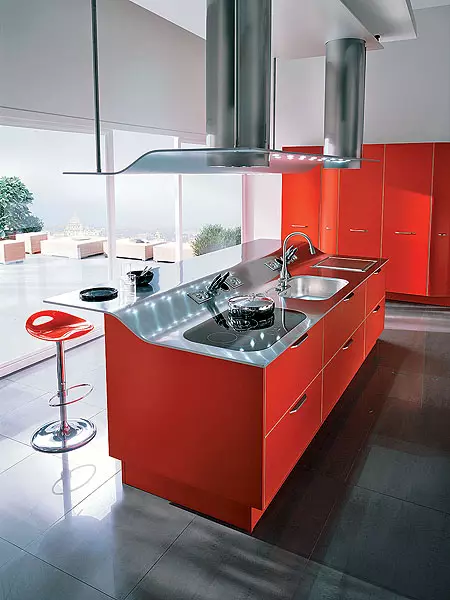
The secret of the attractiveness of the kitchen Venus (Snaidero) is in its brightness, underlined with light elegant lines. Land of facades used microtouch microfiber material with genuine leather effect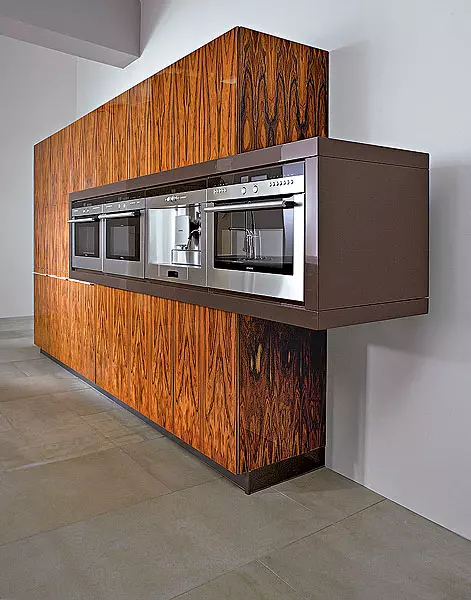
Designers of the German company Leicht definitely believe that modern cuisine must partly play the role of wardrobe. Options can be very different, such as Largo model cabinet with lacquered doors.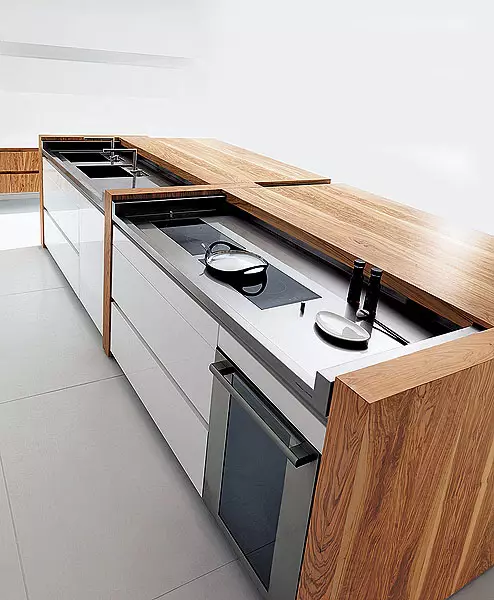
Essential cuisine opened by the secret of "mutual understanding" between various materials: white glossy varnish, olive tree veneer, stainless steel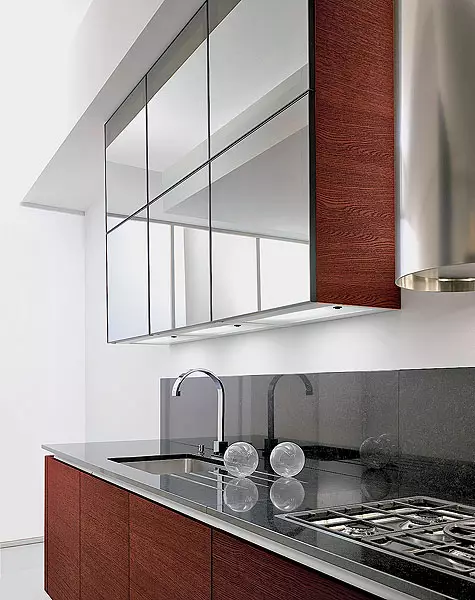
Timo Wood (Biefbi) is provided with a kitchen, everything that determines the comfort and unique expressive style of furniture. Applied materials: MDF, veneer, varnish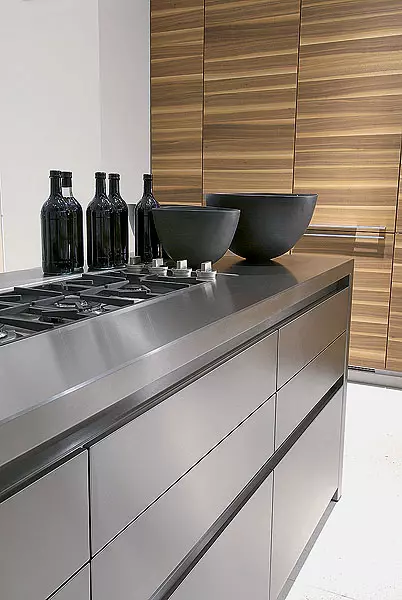
To evaluate German quality, it is enough to look at the head of the working table, spend your hand along the technological seam of the sink or touch the surface of the facades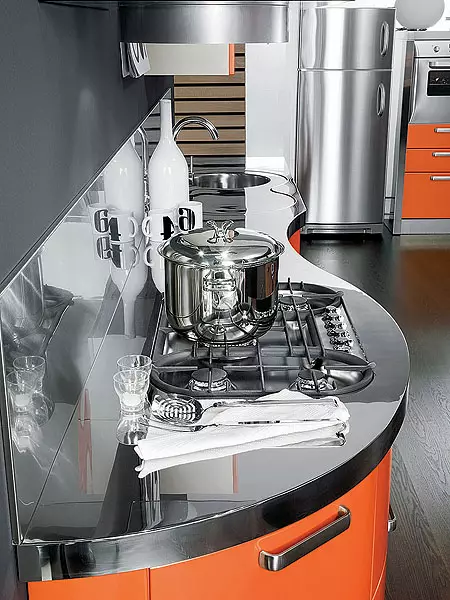
The lacquered facades of the Lucky kitchen constitute a dazzling composition with a tabletop and stainless steel wall panel. The model of the model laid many non-standard solutions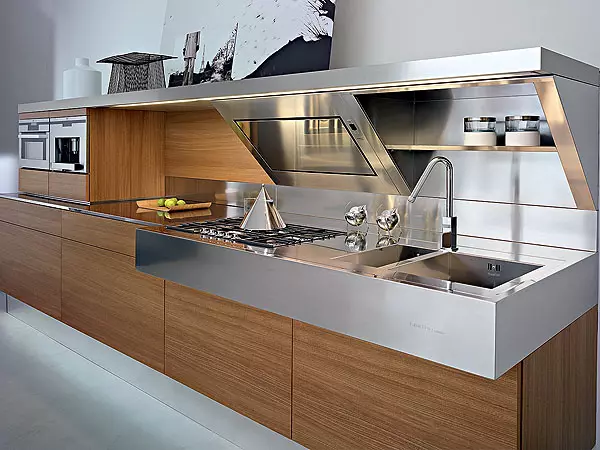
Kube is a sample of an innovative approach to the design of a kitchen, which combines simplicity and functionality. The materials are emphasized contrast (array of knit and stainless steel)
Not every user, choosing a kitchen, thinks about what materials it is made. Nevertheless, it is precisely the consumer properties of furniture, allow the designer to turn it into a unique object, and buyers consider the features of its premises and requests, among which the practicality is not in the last place.
A kitchen furniture kit consists of the following parts: modules (upper and lower cabinets, columns), each of which is a housing (roof, walls, bottom) assembled with facades; Working surface - countertop; Profiles and panels (cornices. Upper and lower, socles, plinths, wall panels, mencols).
Any of these elements implies its requirements for the materials defining the design and style of the kit. But with their choice, first of all three factors should be taken into account. First, cooking is always accompanied by evaporation, temperature drops, splashes from the cooking surface, etc., so that the furniture should all withstand it. Secondly, the kitchen is actively integrated into residential space and is designed to fit him visually. Yves-third, materials significantly affect the final value of the set.
We have already told Overwork surfaces ("IVD", 2008, №2). Present article will talk about what corps and facades prefer taking into account the materials used for their manufacture of materials. Possessing these knowledge, you can easily pick up the kitchen for yourself, your family, your own way of life, strictly putting in the budget allotted for this.
Behind the line of Front
Frame, or body, most cookies are made of laminated chipboard (LDSP). Factories, producing middleweight and high price segments, as well as cuisine under ancient array, can manufacture and enclosure elements from an array or MDF. Factory "EKOMEBEL" (Russia) In addition to the frames of massif and buildings in the standard version (LDSP), it offers models in which only the walls of the extreme cabinets and the Tumb, the sidewall of the foam under the integrated refrigerator or the oven, and all other parts are made from the birch or oak - from LDSP.Typically, the thickness of the LDSP for the production of housings is 16-18mm. It would seem that the difference in 2mm is insignificant, nevertheless, in Europe, the use of 18-millimeter panels in the furniture industry is generally accepted. Due to the larger width of the edge side walls, the roof, the shelves of cabinets look solid. The same frame is tougher, and therefore reliable. Pay attention to this and in the case when ordering the end, completing the composition or separately standing modules.
The rear walls and bottoms of drawers even in the kitchens of the economy class make from LDSP. But today, the leading Russian manufacturers perform them from HDF- High Density Fiberboard (High Density Wood-Fiber Plate).
Although the components of the corps we call the invisible part, in fact they, too, in sight, when the doors are open. Giving this great importance, Nolte Kchen (Germany) uses the same decors for finishing cabinets outside and from the inside. Year of year, they are becoming more and more diverse. B2009 Decors for internal lining of cabinets are released in new colors: Boston Cherry, Savannah Acacia and Noce Amador, quickly become popular.
Parade side
The facades (fronts) are the door of the cabinets, the front panel of retractable structures is always in sight. But count how many times you open and close the lockers, roll out and hatch boxes ... Anezbezhny consequences of culinary creativity, traces of palm of your inquisitive little helpers IT.D. The conclusion is obvious: you need to choose the facades on the basis of considerations of not only aesthetics, but also practicality, and, of course, the degree of your readiness, or rather, the opportunity to care for them.
The range of facade materials is extensive. These are slab materials (chipboard, MDF), wood array, furniture shield, metal (more often, stainless steel and aluminum), glass, acrylic and even ceramic tiles (for kitchens in construction) in all its diversity.
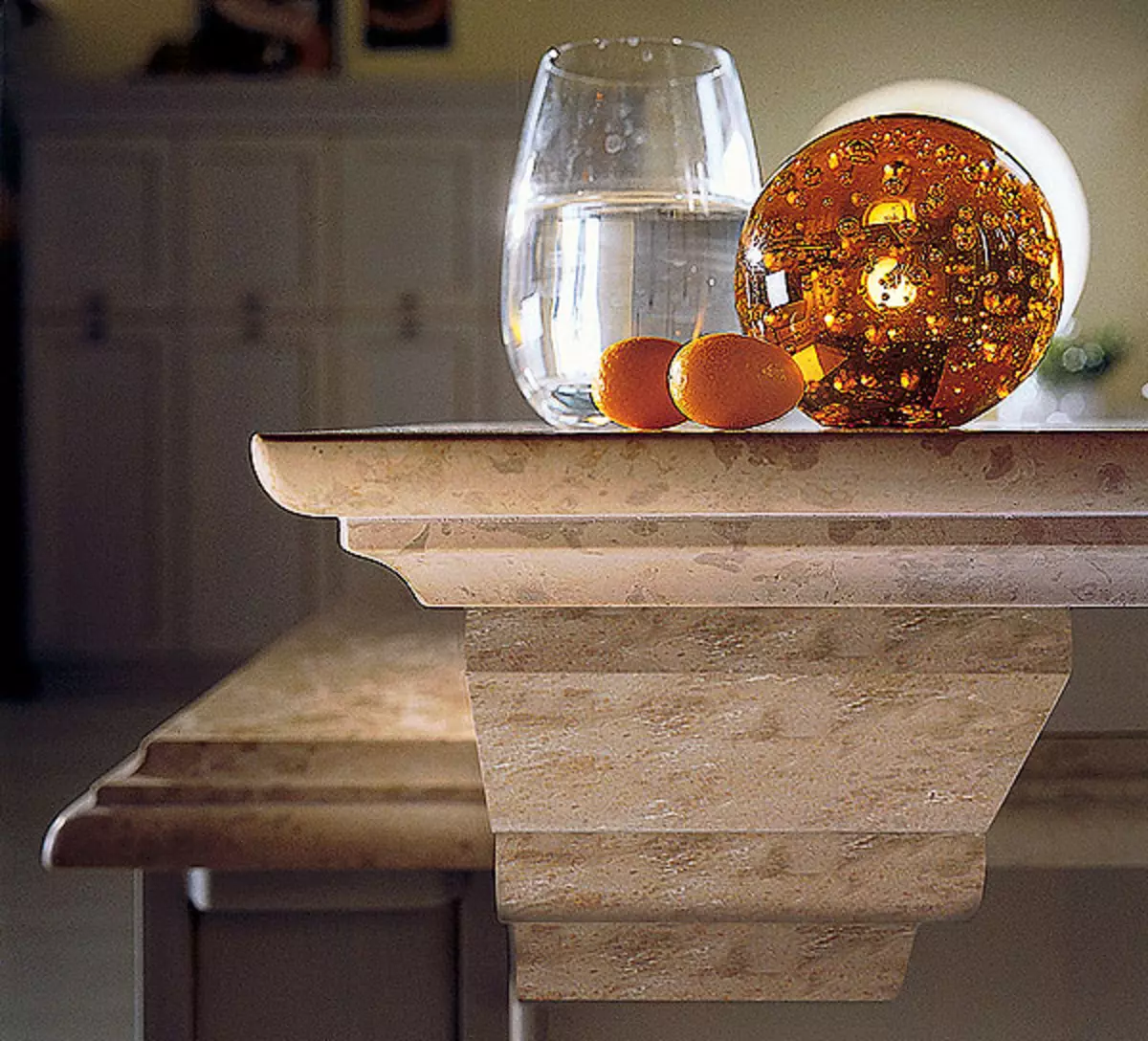
ASTER CUCINE | 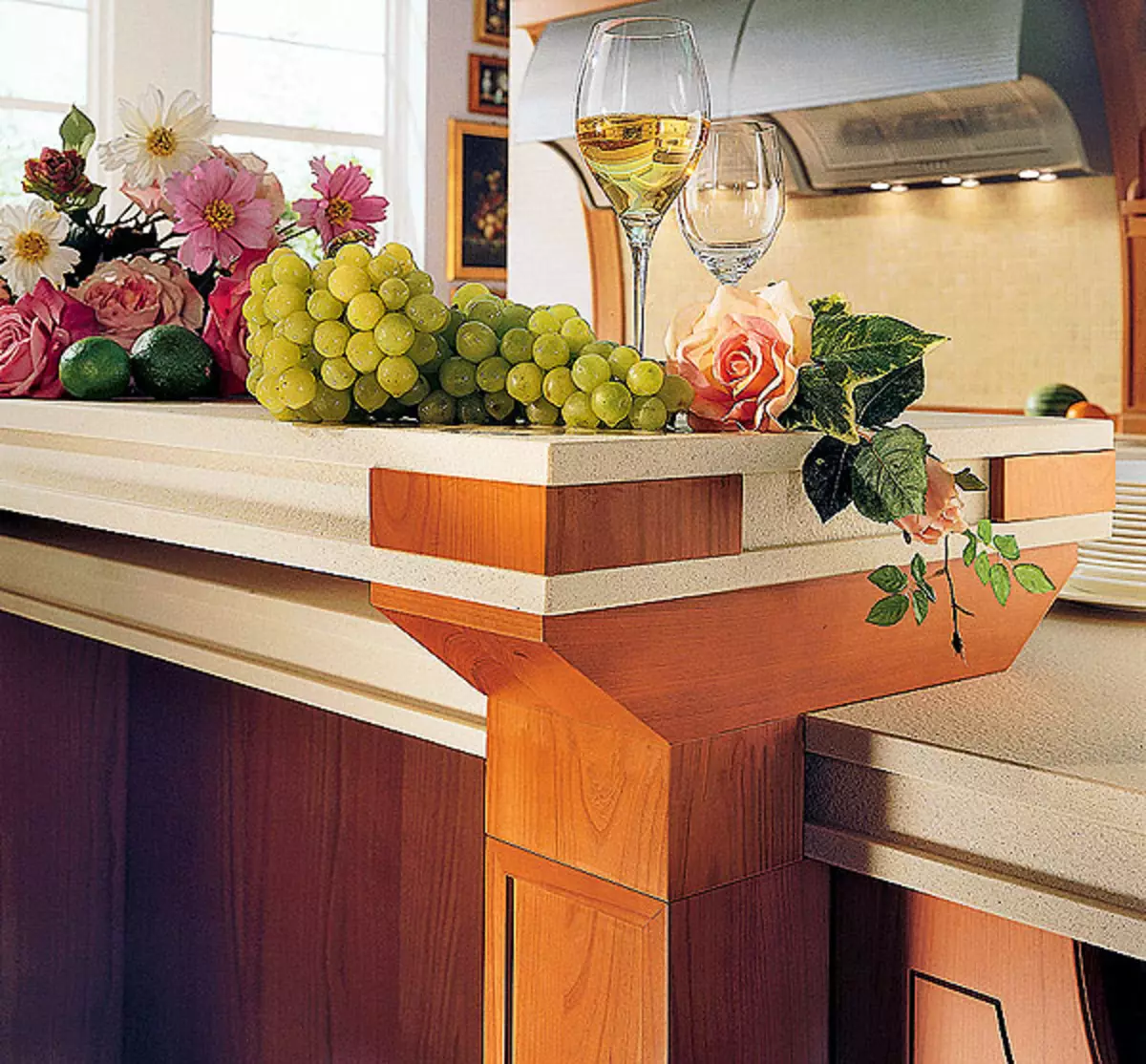
ASTER CUCINE | 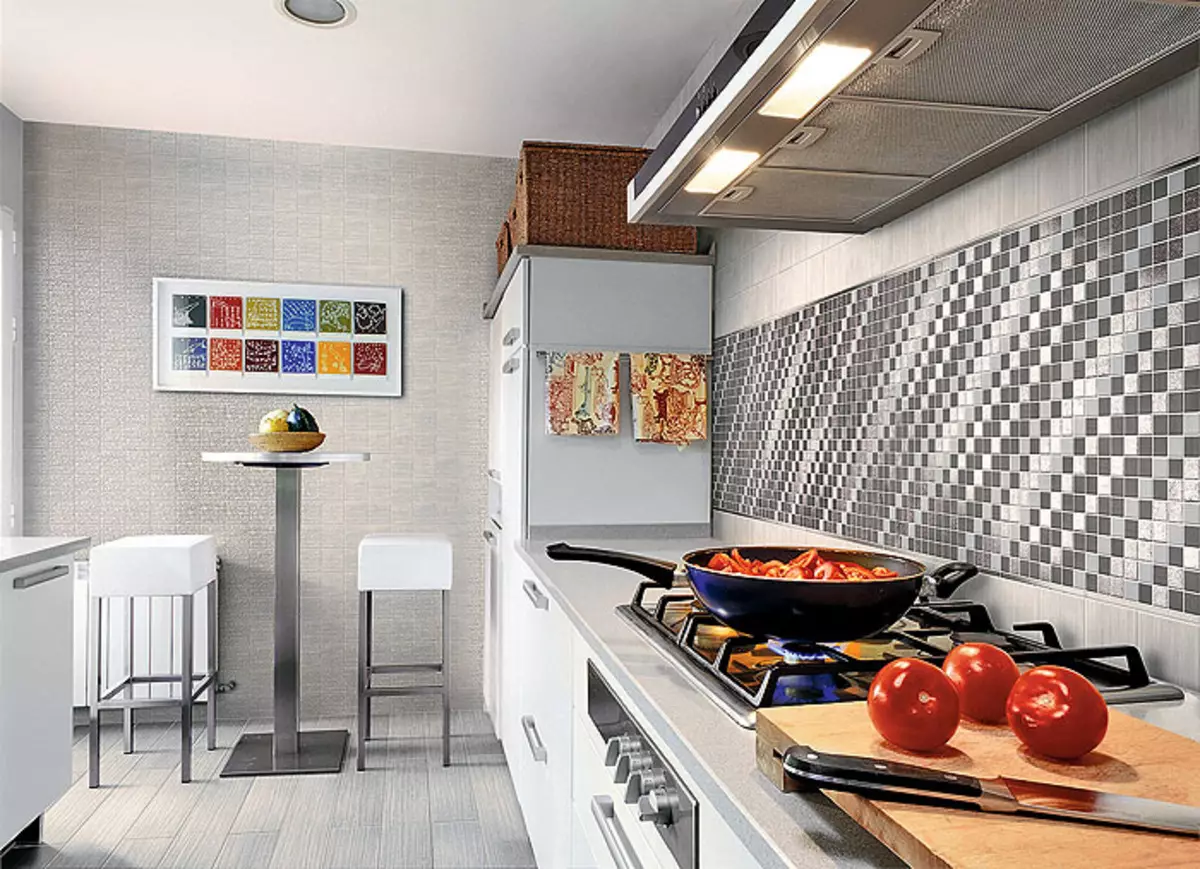
|
1-2.Classical kitchen Palladio with carved fragments.
Constructively facades can be solid (straight) and framework (palenechandes). The solid is made of one material, the framework consists of a frame-strapping (18-24mm thick) and insertion-fillets made of fine (6-12mm) finishing boards, plywood with relief pattern, plastic, glass. If you want to combine different materials and color, the advantage of the framework designs is obvious. Users who plan to create an unconventional and at the same time functional cuisine, will continue to implement the task and to save a little, choosing the strapping more expensive, and the panel is cheaper.
Monochrome frame facade - indispensable element of kitchens in country styles and classic.
One-piece facades are in demand in minimalist cuisines with extended surfaces, where considerable importance is attached to the invoice. For smooth planes of solid facades, it is easier to care (in the junction of the junction and insertion still clogs dirt). But most often in one kitchen combine solid and frame facades, for example, smooth from MDF and frame with glass.
Construction materials
All materials forming the appearance of the kitchen are divided into structural (facades are performed from them) and finishing, or facing (they decorate the facades).
Chipboard. The most common material in the production of furniture is chipboard. Many European manufacturers whose kitchens are beautiful, practical and safe for health work. The best chipboard is recognized by German (EMISI class E1). New generation wood-chip plates have increased density, waterproof. For the manufacture of kitchen facades, the plates of the 1st grade with a thickness of 10-26mm are used.
"Narrow places" of any products from the improacted edges of the plates. Therefore, self-respecting and customers producers close the edges, all, even those that are addressed to the wall or are in the nodes of the connection. "Naked" ends are one of the signs of cheap furniture.
To protect open ends, an aluminum edge is also used, an aluminum mortise end profile (for facades from plate materials) and aluminum frame profiles in which various types of glasses or acrylic are assembled.
Opinion of a specialist
The working area of any kitchen is constantly in contact with water and is subjected to significant temperature drops. Among such materials such as plastic, glass, metal, natural stone used to finish the kitchen "Apron" (zone between the upper and lower cabinets), the undoubted leader is a ceramic tile. Its use is the most common designer option. Ito is not accidental. The tile has excellent consumer qualities: it is durable, waterproof, refractory, it is easy to wash. The same tile manifold allows you to realize any fantasy designers. For kitchen "Aprons", special series of tiles of 1010 cm are developed. The deposits and facades of the Depositical European Tradition are facing such ceramics, and A la Provence Retroetetics fans choose a series of tiles stylized under manual molding or deliberately rough rustic.
For Russia, unlike Mediterranean countries, facades and countertops, lined with tiles, while a new trend. Of particular interest in this regard is made by the retalified (seamless) series of porcelain stoneware, which make it possible to easily keep clean the surfaces in the purity. It is important to remember that the correct laying and the quality of the grout used here is important, because the kitchen is the zone of the most "harsh" operating conditions in the apartment. The maternity owners will be not interesting to find out that the kitchens in the construction execution lined with ceramics are much cheaper.
Igor Paskin, director of the salon "Ceramics"
Pros. Lifted slab material with good features: It is durable products, unpretentious in operation. The rich color range of facing materials, the inclusion in the glass composition, the framing of the facades by aluminum profile - all this will help create aesthetic and practical kitchen for all occasions: for a family where they cook a lot, and the room is small; for family with a modest budget; For a young couple, while not ready to invest considerable money in the kitchen.
Minuses. Chipboard is rather loose inside and do not allow fine processing. As a rule, facades from chipboard are direct, and rounded end modules, bent facades, carved items made from the chipboard. But it is unlikely that it is a minus, because the design of many kitchen-straightforwards.
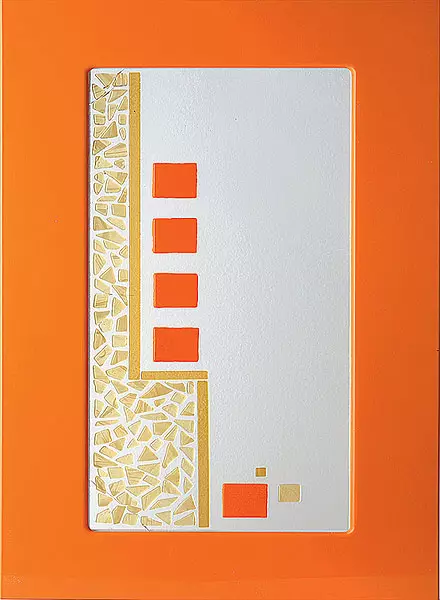
"Stylish kitchens" | 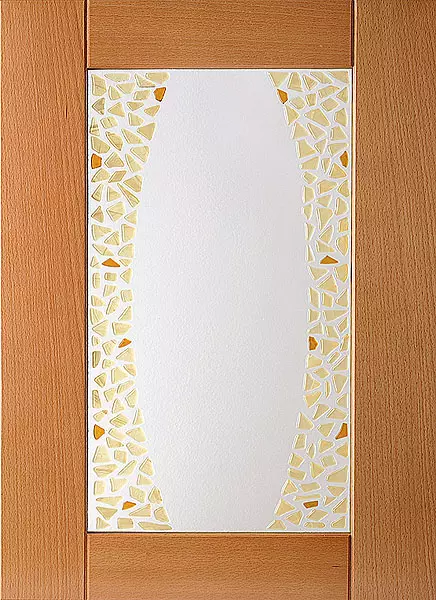
"Stylish kitchens" | 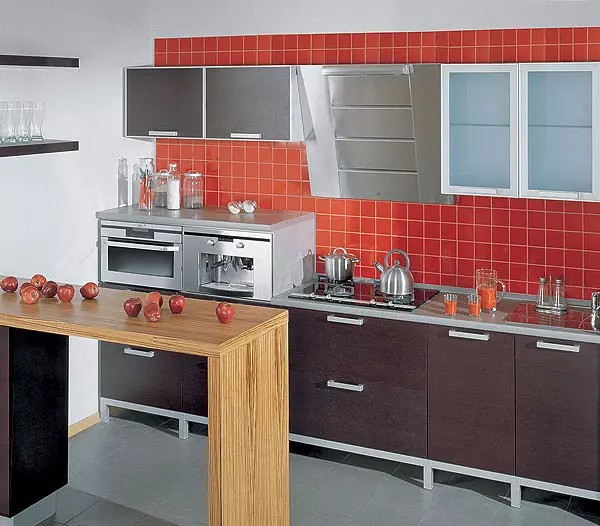
"Stylish kitchens" |
4-5. In our homes, color paintings made of glass in fusing technique are found. Therefore, the facades with such inserts look especially bright and original. To care for them is as simple as for ordinary glass.
6.Kuchni from MDF, finished film, change their appearance in accordance with the selected texture and color. The variety of combinations will satisfy any consumer requests.
MDF. Kitchens with facades from MDF (middle density wood material) are widely represented in the model ranges of almost all foreign and leading domestic manufacturers.
Pros. As for the practical side, the kitchen facades from MDF are strong (perfectly held fasteners), do not swell, do not be blown, and even natural wood are sometimes superior to moisture resistance and mechanical characteristics. So a single important factor-ecological purity of the material. Plates are made without using phenol-containing binders.
Products from MDF can be significantly cheaper than products from the massif (sometimes 60%). However, we will be careful with such conclusions: many famous design cuisine are made precisely from MDF, and they are much more expensive than standard modules from a relatively inexpensive birch array or even more pine. Flexible, durable, homogeneous MDF structure are amenable to the thinnest processing methods and can take various forms, so when ordering a kitchen, you can not limit yourself with rectilinear facades, and incorporate bent (radius) elements in the composition, choose some kind of relief, carved panels. Facades from MDF are not only faced with a variety of film materials, decorated with veneer, but also paint, lacate. To do this, there are durable, non-burning enamel (glossy and matte) of any color.
Minus. The inner side of the facades in the standard version is white. It is not very beautiful (with the exception of white kitchen) and impractical. But you can order facades painted on both sides.
We will have a price of 1Pog. Kitchens with facades from MDF- 10T. rubles.
Array of wood. None of the synthetic materials can compete with a tree with a noble multifaceted beauty and unique characteristics. However, even the classic facades from a solid massif are extremely rare - it is expensive and unpredictable in operation. Manufacturers most often make facades from a set of wood, from dried wood bars cut and assemble in papers on special technology. Such elements are less susceptible to external influences. An exception can be cuisines in the country style made on a long-standing manual tradition. Fileniki wooden doors are often figured, decorated with decorative threads, embossed elements. The effect of the old furniture is achieved by patinating (aging), driven by carnations, specially made cracks (craklers), "seeded bug" surfaces, etc. Such furniture is produced by Verona, "EKOMABEL" (both- Russia), Formaglio, Francesco Molon, Maggi Massimo (All Italy), Chemines Philippe, Mobalpa (Oba France) IDR. But you need to choose a kitchen in the country style with heart and love it with special love. Such kitchens fit in particularly harmoniously in a relaxed atmosphere of a country house.
Opinion of a specialist
Kitchen housings are divided into glued and prefabricated. The details of the glued are connected to each other in the factory conditions on special presses, where the angle 90 is withstanding. Each cabinet is brought to the client in the assembled form, with an already hung and adjusted facade installed by handles. Kitchens with glued housings look aesthetically (not visible screeds, there are no gaps between the facades). It is also considered that glued frames are stronger. They are mainly produced by European factories, as well as domestic, which have modern production and offering products of medium and high price ranges. The rest of our enterprises produce prefab kitchen housings, and the facades are ordered from other manufacturers. The kitchen is completely disassembled and collected on the site from the customer. This is caused by the high-cost specialized equipment and not highly qualified working personnel. However, subject to professional assembly at the site, the quality of prefabricated kitchens does not deteriorate, especially since, if there are lateral decorative panels, you can hide the attachment nodes. In addition, the kitchens supplied in the disassembled form are cheaper, it is possible to fit the elements in place, and replace the defective parts is easy.
Sergey Melnikov, Commercial Director Complete M
Pros. Facades from the wood array are environmentally friendly, can have any shape and decor. Wood combines in the interior with all materials. Finally, she can grow beautifully. The same surface of the wood array can be restored.
Minuses. Tree is sensitive to sunlight (able to change tone), humidity, temperature and can be sworn. It is difficult to predict how facades from the massif will behave in our far from a stable climate and when the air is dried by centralized heating, which included most of the year.
If you are able to provide air humidity 65-79%, do not be lazy to rub the scratches (and they are inevitable) with a special means, "pamper" the surfaces of wax mastic, if for you it will not be burdensome when cleaning the facades wipe them in the direction of wood pattern, immediately delete From the surface of the water spray IT.D., the kitchen from the massif is created for you.
Io prices. Set with pine facades worth 9-10 thousand rubles. For 1Pog, from beech or oak, from 12 thousand rubles, from more expensive wood breeds or more complex configurations, respectively, significantly higher.
Decorative passion
Main methods of finishing of plate materials: cladding with paper-resin and polymer films, decorative paper-layered plastics, natural or artificial (final) veneer of the tree, as well as paint coating, enamels, varnishes, etc.
Veneer. This is a thin layer (0.6-3mm) wood produced as a result of brimple, planing or sawing logs.
The most expensive is the planed veneer. Today, a modified planed veneer is more common, which is made by planing the block glued from the lined veneer. The plates lined with veneer must be applied with a protective lacquer coating.
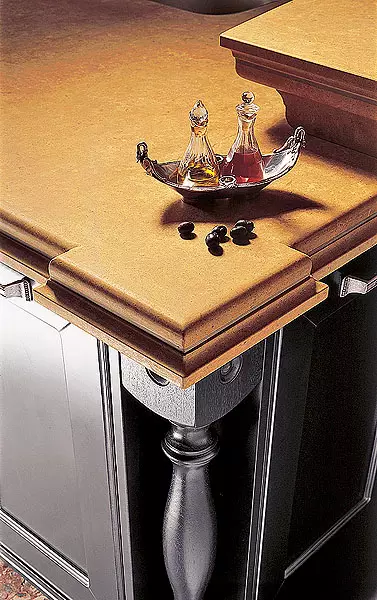
ASTER CUCINE | 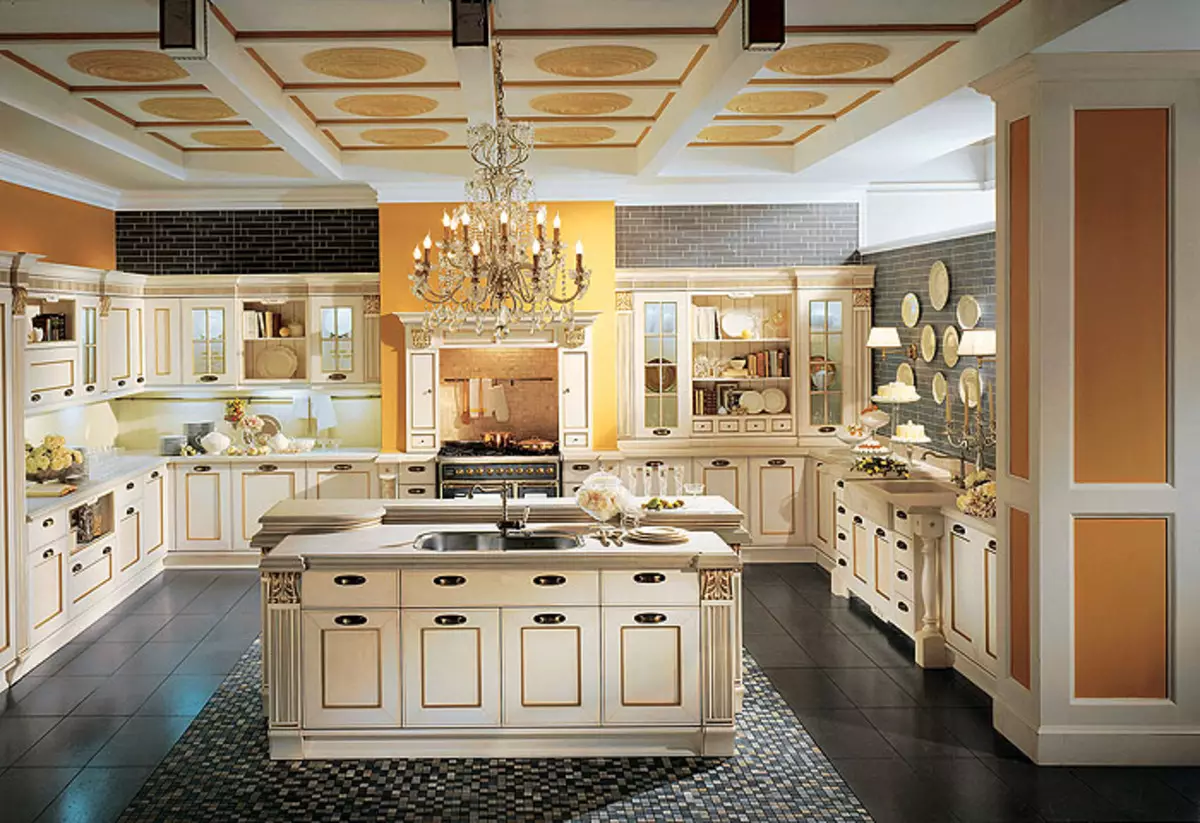
ASTER CUCINE | 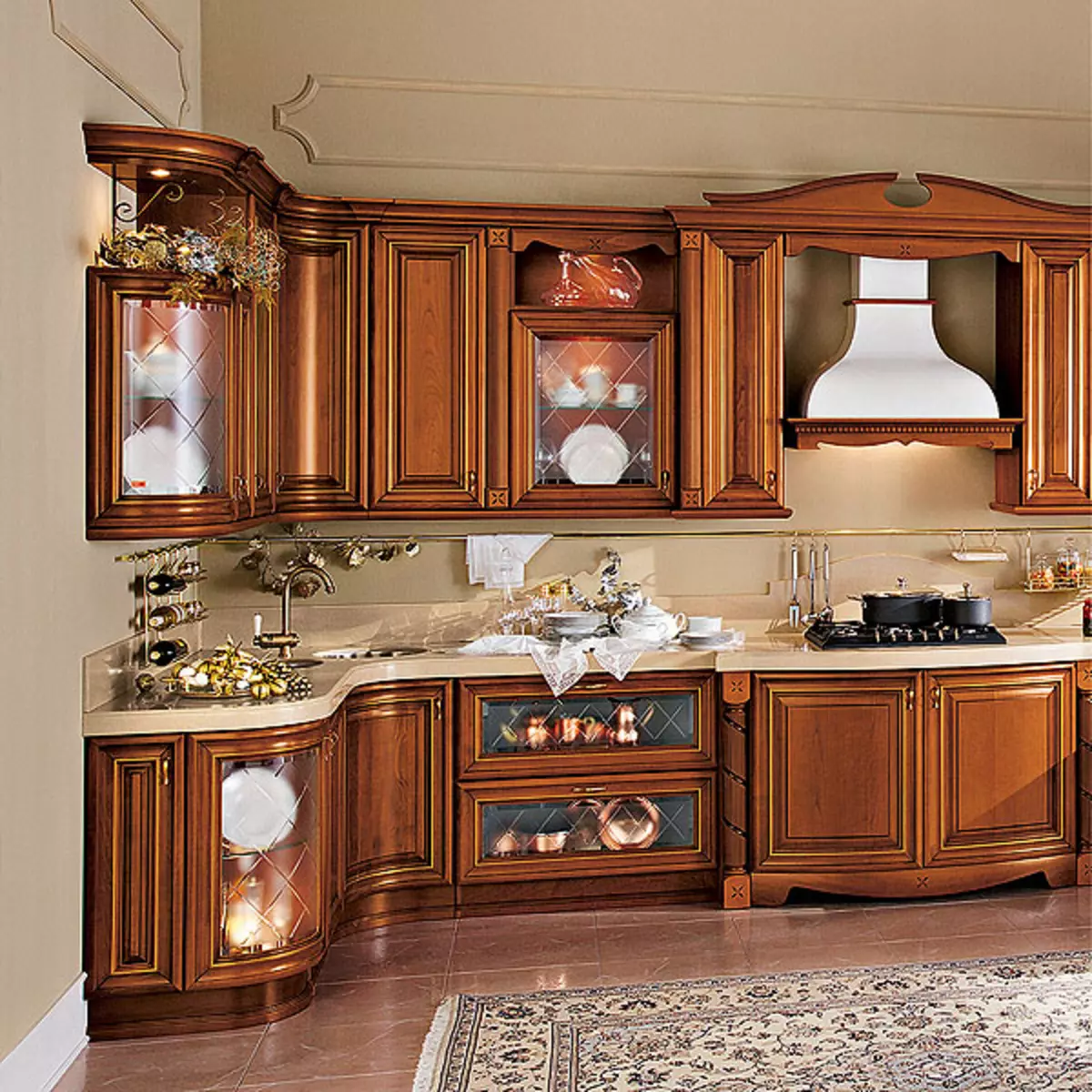
Verona. |
7-8. High-minded solution of the kitchen with the poetic-theatrical name Opera (ASTER CUCINE) is inspired by the Italian Renaissance. This is perfectly equipped kitchen space.
Facades, lined with veneer, cheaper than made of array, less capricious in operation, but visually retain the warmth and texture of natural wood. In addition to the veneer of the breed-oak, cherries, beech, birch, walnut, maple, chestnut - for decoration of kitchen modules, veneer is used: Anegri, Zebrano, Macoera, Wenge, Makasar, Tika Idre. It is made, as a rule, using Fine Line technology, which was designed to obtain new textures in demand in minimalist design. This veneer is not similar to any of the existing tree breeds, it has its own "face" with a clearly pronounced original structure, spectacular pattern and color. Most often in frame (fillety) facades for facing the frame use natural veneer. Punching of solid (direct) facades usually use Fine Line.
Paper-layered plastics. There are two types of facing paper-layered plastics: HPL (high pressure laminate 0.3-2 mm thick or more), characterized by high wear resistance, and CPL (low pressure laminate 0.15-1.2 mm thick). Cheap Economic Sets with facades, lined plastics, is a modern approach to solving the task of the kitchen arrangement. Such facades do not have restrictions on color, with them it is easy to remove dust, dirt and fat stains, besides, they have a high level of strength, do not fade under the influence of sunlight and are able to serve for many years.
Manufacturers constantly develop new plastic coating options. Thus, technologists and designers of the Bauformat factory (Germany) offered the original anthracite color facades made by new technology under the oak veneer. The texture of the drawing is preserved, moreover, some "incorrectness" of natural material is reproduced, as well as a rough structure of a natural veneer. It's nice that the facades and the hulls in this design refer to the category of inexpensive. You can buy wall panels with them, which make up a single ensemble with furniture. Another novelty of the German factories is a group of plastic facades Flash ("Flash", "shine"), visually not distinguishable from the glass. But, possessing many characteristics of the glass surface, they are deprived of its considerable weight and fragility.
Actively developing direction in the decoration of kitchen modules finishing them with acrylic plastic, which gives the interior lightness and modern appearance. This is a decent alternative to varnishing. With water cases, this high-tech product has a unique degree of gloss, a saturated color, an ideal surface, in the other velvety surface with the Satin effect, pleasant to the touch. Families with young children or allergies or in which the hostess prepares a lot, we advise you to look at similar sets. They are beautiful, practical and absolutely harmless to health. Plastic shockproof and resistant to scratch, not afraid of contact with water. However, he does not like the abrasive effect of detergents.
Film materials. The facades decorated with films attract the optimal ratio of "price quality". Mainly, these are films based on polyvinyl chloride (PVC), polystyrene, acrylic polymers IDR. The advantage of polymer films is the possibility of facing of profile products. Disadvantages - low heat resistance and not the best physicomechanical characteristics of the resulting coating. They are used to failing cladding, the strength of which strengthens the strapping.
Some factories, such as "stylish kitchens" (Russia), offer patinating of film facades. The lined film element is applied to a patina and fixing the lacquer, which gives the product a noble and respectable look, as if it was made of an array.
Patent reality
Lacating painted surfaces known for a long time. Lacoine hygienic material with excellent performance characteristics that increase the consumer qualities of the kitchen. The more layers of varnish (minimum four), the stronger and more expensive finish. For facades from MDF and wood massif, varnishes are used: matte, structural, mirror, high-chance (this type of coating is considered one of the most expensive). Kitchens made in glossy varnish - a symbol of the success of the owners. Let's make a lot of "piece", designer models. Now, this technology is often used in their collections of the company, producing medium and high price levels: Alno (Germany), Berloni, Scavolini (Obaalia), Nolte Kchen Idre.Processed from all sides by glossy varnish panel reliably protected seams, no joints. However, choosing a glossy kitchen, you should remember: all brilliant requires special care. I and you have small children in your family, it is better to purchase a more practical option.
Matte varnishes give a warm, "soft" velvety surface. Any color on the RAL scale is possible, obtained by adding pygima. Lovely from a high gloss in matte surfaces does not remain traces from fingers, and scratches are practically imperceptible.
Structural varnishes, creating the effect of a variety of texture (for example, "metallic") appeared in Germany at the end of 90-hgg. Hchw. They allow us to get a rough, pleasant to the touch, "warm" invoice. True, structural varnishes are expensive, and they are used by manufacturers whose products are inherent in the highest quality: Allmilm, Alno, Bulthaup, Hcker, Miele, Nolte Kchen, Wellmann (all Germany).
From new coatings, it should be noted by the polyester, which the Italian Factory novalinea separates its cuisines. Polyester-type of liquid plastic, is applied to the facades in 16-18 layers. The result is the surface similar to the glass.
Fantasy on the topic of glass and metal
Glass is one of the most winning materials in the interior of both modern and classic cuisine. It is very aesthetically hygienic, introduces an extra depth, opens the space for emotions and revives the kitchen. Matted, corrugated, tinted, reinforced glass with the inclusion of metal filaments is widely used.
Stainless steel in the kitchen is primarily practicality and hygiene. The kitchens with perfectly treated gray facades and steel work surfaces in tandem with casting cooking blocks similar to professional, look specthecus. True, Zashlikovka scratches is not easy. But the operational qualities of the scratches do not affect. Now the manufacturers have learned so to process the steel that fingerprints remain on its surface. "New love" designer - silver "silk" light aluminum. Today it is present in the kitchens not only exclusive, but also the average price category. They frame doors, profiles, base. However, we note that this metal belongs to the number of the most expensive materials.
The editors thanks the company "Decoration", "Ceramics", "Kitchen Maria", IBTM, "Stylish Kitchens", "Ekomeber", Complete M, Nolte Kchen, Verona Mobili for help in the preparation of material.
